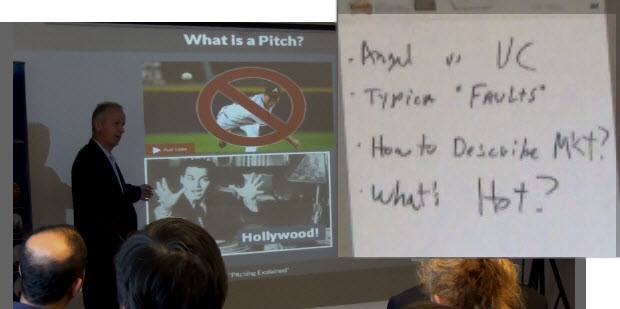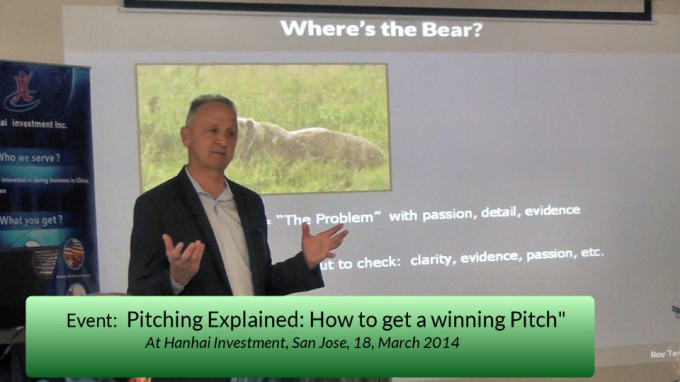Join me at a free open workshop where you can learn about winning pitch structure and technique. AND practice both in small groups and to the whole room. Tuesday, 13 May 2014, at 12:00 in San Jose. Full Details are here on Meetup.com
Uncategorized

Pitching Explained: 4 key questions from the flip chart
Here are the questions from last week’s workshop that we still need to address directly.
- Difference pitching to angels or VCs?
- Typical Faults in the pitch
- How to describe the market and the competition
- What’s hot (What investors are most interested in)
Do Angels and VCs need different pitches? No. But the style and formality will probably vary a lot. Keep in mind both kinds of investors need the same information in order to justify their risk of investment. But the stakes are higher in absolute money terms for the VC. The angel, risking smaller sums may decide to “make a bet” more quickly on less information. Because, afterall, at the angel stage you have accomplished and proven less. I believe an angel pitch will probably rely more on claiming a high value potential in your unique solution and talents. Those things you will have at early stage. For the VC, they will expect further validation of your market potential, competition, go-to-market, etc. These are two variations of the same pitch just optimized for the audience and data you have at hand.
Typical Faults in the Pitch. This is just review of the workshop. 1) Structure is muddy. Follow format of Problem, Solution, Market, Business model. 2) No Bear: make sure your problem description includes impactful detail and emotion about the seriousness of the problem and the number of people seeking a solution. 3) Tell a story of discovery or a story of “proof” of the validity and appeal of the solution.
How to describe market and competition? Start with a review of MBA style materials on line or on your bookshelf. Markets are described first in terms of dollars. The size of a real or hypothetical market ia annual dollars spent. Then there are fancy ways to further detail using terms TAM, SAM, etc. Thing is, many startups are looking to CREATE new markets or extend established markets in disruptive ways. What then? I have seen no fixed rules except numbers and logic. You should compare your “new” market with similar markets for similar people seeking to solve similar problems. Then you can make a whole serious of logical steps to justify your market claim. Keep the steps as few as possible, the logic tight and the numbers easily findable on Google, etc. You will be challenged to justify your claims! Get the market claims in your pitch reviewed and critiqued by an expert in your segment. Please! Another helpful “starting out” resource from an Oregon incubator
What’s Hot (what are investors currently interested in)? This is a bit like asking what kind of movie Hollywood wants to make next year. They want to make a winner! In Hollywood being a copycat is more convincing than being a copycat in silicon valley. Every enterprise must have a unique value and positioning to succeed. Now the hot buzzwords are certainly still big data, the cloud, customer facing architecture, mobile apps, social networks for special interests and the internet of things. But what will sell is your unique proposition and you’ll have to have passion behind it. So this question is not so useful unless you can get your passion adjusted to match the buzzwords. Paul Graham’s advice, “Just make life better for people”
Roy
Pitching Explained – Here are links to other resources
Dear meetup attendees, the slides I presented were meant to be a “fly by” of samples and examples of pitching best practices. If you’d like to follow some of those same starting points (and also please do search on your own with Google, YouTube, and slideshare) Here is a run down of the content. (a few more yet to come…) – Roy
Chris Lipp Presented on pitch structure, also at Hanhai back on 4 April of 2014 Chris advocated for the pitch structure of
Problem, solution, market, business. I agree with and advocate this same structure
Our happy and successful young pitch master was founder of Lit Motors, Daniel Kim.
Bill Gates and “half of start ups are silly” story at Business Insider
Here are the slide deck experts and examples
Nathan Gold of thedemocoach.com And his YouTube video about slides and pitching
Steve Austin of “Idea to IPO” with another slide deck (links below image)
Here is the 3rd deck example from slidshare. I shared slide #42

Pitching Explained – Here’s the slide deck from 18 March
Thanks to everyone who attended the Pitching Explained: How to get a better Pitch Event !
As promised, here is the slide deck in Powerpoint: Pitching-Explained-Get-A-Winning-Pitch-18March2014
I will add more links to people and content mentioned as time permits. If you gave me a business card I will email you when all the material has been added.
Or you can just comment on this post with an address and I will add you to the notification list.
Roy

Introducing The Primal Pitch
There are three things every new founder or entrepreneur needs to know about pitching.
- It’s harder than it looks!
Ever been to a pitch practice or even a Toastmasters club? Even the smartest person in the room seems to shrink as they speak to the group. And, unless you’ve secretly practiced from age 10, your experience will be the same. Don’t let the cold water discourage you because you will get better! - Pitching doesn’t need to be that hard because at base it’s an extremely simple challenge: Share common concerns, invoke a solution and envision the new future. Feel free to read that sentence again. It is the bare bones minimal structure of every pitch.
- Progress is quick if you STOP practicing he wrong way and start following step #2.
There. Pitching Solved. (I wish!)
The Primal Pitch is dedicated to following these points and helping anyone and everyone who seeks pitch improvement to progress as fast as possible. And there’s more. Primal means the pitch is more than information. Primal means the pitch is also a performance, preferably planned!
Please signup to receive notice of events, videos and monthly highlights as we take on the great pitching challenge right here in Silicon Valley.
Best Regards,
Roy Terry












